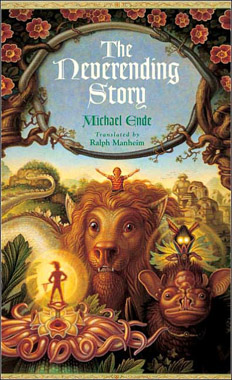The Neverending Story
by Michael Ende. 1979.
Reviewed by JoSelle Vanderhooft
 Like any good child of the 1980s I grew up on Wolfgang Petersen’s 1984 film The Neverending Story. I was obsessed with the Sphinx Gate and the Southern Oracle; I wanted my own pet Falcor the Luck Dragon; Gmork the wolf gave me nightmares. But like many of my generation, I was not immediately aware that the beloved film (and its disappointing sequel The Neverending Story II: The Next Chapter) were based on the book of the same name by German author Michael Ende, a book I read for the first time in 1991 as a lonely sixth grader who had very much in common with Bastian Balthasar Bux, the book’s heavyset, unpopular and bibliophilic protagonist. And it was only in 2008 when revisiting Fantastica again that I realized something: Ende’s book is not only an anodyne for isolated, bookish people, it is also ‘” like most literary anodynes ‘” a beautiful fairy tale.
Like any good child of the 1980s I grew up on Wolfgang Petersen’s 1984 film The Neverending Story. I was obsessed with the Sphinx Gate and the Southern Oracle; I wanted my own pet Falcor the Luck Dragon; Gmork the wolf gave me nightmares. But like many of my generation, I was not immediately aware that the beloved film (and its disappointing sequel The Neverending Story II: The Next Chapter) were based on the book of the same name by German author Michael Ende, a book I read for the first time in 1991 as a lonely sixth grader who had very much in common with Bastian Balthasar Bux, the book’s heavyset, unpopular and bibliophilic protagonist. And it was only in 2008 when revisiting Fantastica again that I realized something: Ende’s book is not only an anodyne for isolated, bookish people, it is also ‘” like most literary anodynes ‘” a beautiful fairy tale.
For those familiar with the movie, the book follows basically the same plot, though with more complexities. Bastian is a lonely little boy whose weight and awkwardness have made him the butt of his classmates’ cruelty and whose grief over his mother’s death has isolated him from his father. One day, Bastian hides in a used bookstore to escape some particularly nasty school bullies. Here he discovers and steals a curious leatherbound book emblazoned with an oroborous and titled The Neverending Story. Secreting himself in the school’s attic, Bastian begins to read. Little by little, he is drawn into the world of Fantastica and into a boy named Atreyu’s quest to save his empress and his world from the force known as the Nothing, which is killing them both. Eventually, Bastian gets literally sucked into the book’s pages and into a series of his own adventures which are only as fantastical as the wishes that he makes. But little by little, these wishes erase his memory of his world and which may strand him in Fantastica forever.
To me, the above paragraph sounds a lot like certain Aarn-Thompson tale types. Despite the modern devices of bookstore, schoolhouse and magical tome, The Neverending Story is first and foremost a tale of a child who ventures into the dark woods. All of the elements are present: parental abandonment (through death and emotional distance), social isolation and a bona fide journey into terra incognita. So, too, are several fairy tale tropes: the quest, the princess in distress, the magic gates through which the hero must pass and which test his courage and resolve. The characters Atreyu and later Bastian meet are also familiar fairy tale types. Along with the typical wise scholars, craven monsters and even princes, princesses and sorceresses seemingly ripped straight from Arthur Lang’s Fairy Books, The Neverending Story also deals in infinitely more powerful and more primal archetypes, including figures that appear to be stand-ins for Bastian’s parents. In my favorite chapter, for example, Bastian enters the House of Change where he meets a woman named Dame Eyola, who has flowers and fruit growing from her hat and dress. At the risk of spoiling too much for the first time reader, Eyola feeds Bastian with these fruits and nurses him back to health with what he needs the most: a mother’s loving care. In this way she is very much like the monomythic mother goddess Joseph Campbell identifies in The Power of Myth. In fact, the redress of maternal loss is a key element of several fairy tales ‘” as in several versions of Cinderella and Snow White. What makes it so striking in The Neverending Story, however, is that this particular chapter portrays a boy seeking ‘” and in some sense ‘” finding his mother, and doing so in a way that does not evoke the standard Oedipal themes which are as old as, well, Oedipus.
Ultimately, it is The Neverending Story’s ingenious reinvention of the tropes of fairy tale that makes it not just excellent literature, but an excellent fairy story. Rather than an external threat such as the Nothing (which is Atreyu’s main antagonist) Bastian’s quest is an internal one. He enters the dark wood and meets not monsters or the all-devouring Nothing but his own psyche and the frequently selfish and vengeful wishes that drive it. He struggles not merely against his shadow side but against the destructive aspect of the human imagination ‘” against the very human power, if you will, that can create story. And the long road to his eventual triumph feels, in some ways, far sweeter than, say, a more temporal triumph over a wicked stepmother or a cruel king. For at the end of all things Bastian’s ability to imagine is not only his salvation, but the world’s. We, the readers, have shared in his pain and his creativity. We have seen the depths to which imagination can sink and the heights to which it can rise. We have examined our own wishes ‘” both the beautiful and the hideous ‘” and have found ourselves both wanting and graced. We have become a part of The Neverending Story.
To paraphrase one of the final lines in the book, Michael Ende’s creation in many ways brought me the Water of Life as a writer and a dreamer. I imagine it has also done so for those fellow travelers who have become a part of its pages.

